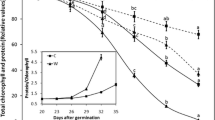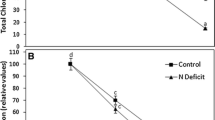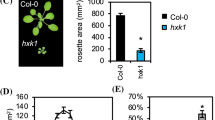Abstract
α-Galactosidase activity (α-d-galactoside galactohydrolase, EC 3.2.1.22) increased during dark-induced senescence in primary foliage leaves of barley (Hordeum vulgare L. cv. Steffi). The changes in activity were accompanied by parallel changes in expression of the HvSF11 gene encoding a putative α-galactosidase. The transcript level of HvSF23 encoding a second putative α-galactosidase stayed constant during leaf senescence. Both α-galactosidase activity and the level of the HvSF11 transcript decreased after exogenous application of sucrose and glucose to detached dark-incubated leaves. In contrast, the HvSF23 transcript level was not influenced by sugars. Application of glucose analogs to detached and dark-incubated leaves revealed that phosphorylation of hexose by hexokinase modulates both the α-galactosidase activity and the expression of HvSF11. These results indicate that the expression of the genes coding for two α-galactosidase isoenzymes is regulated by different signalling pathways, suggesting different functions for the two gene products.
Similar content being viewed by others
Avoid common mistakes on your manuscript.
Introduction
Plant α-galactosidases are important hydrolytic enzymes known to catalyze the hydrolysis of various storage substances in seeds and fruit tissues (Dey and Pridham 1972). Since work on plant α-galactosidases has mostly focused on seed and fruit tissues (Feurtado et al. 2001; Guimaraes et al. 2001), little is known about the nature and function of α-galactosidases in photosynthetically active tissues. However, α-galactosidase activities have also been measured in photosynthetically active tissues (Gatt and Becker 1970; Smart and Pharr 1980). In plant families that synthesize and transport raffinose-family oligosaccharides (RFOs), different isoforms of α-galactosidases occur during the transition of leaves from sink to source tissues (Pharr and Sox 1984; Chrost and Schmitz 2000). In plants not known as synthesizing such RFOs, α-galactosidases are assumed to be involved in galactolipid metabolism of thylakoid membranes, especially in the senescence-associated breakdown of these membranes (Wanner et al. 1991; Thompson et al. 1998). Recent studies, however, indicate that under certain conditions, e.g. freezing, drought and temperature stress, various plants synthesize RFOs (Santarius 1973; Bachmann et al. 1994; Taji et al. 2002; Pennycooke et al. 2003). Investigations on Arabidopsis, which was not categorized as an RFO-synthesizing plant, showed that Arabidopsis leaves synthesize and translocate raffinose (Hariratos et al. 2000). RFOs seem to play roles during desiccation and cold tolerance, and accumulate also in senescent leaves, as shown for leaves of Popolus nigra by Fialho and Bücher (1995).
Leaf senescence is a highly regulated and genetically determined process. Expression of new and senescence-associated genes is necessary for senescence to progress (Quirino et al. 2000). Genes specifically induced during senescence encode enzymes that are involved in the hydrolysis of carbohydrates, proteins and lipids. Senescence is characterized by a significant decrease in photosynthesis and degradation of cellular components like chlorophylls, protein and lipids. One of the most efficient stimuli that accelerate leaf senescence is the exposure to darkness. Since light is essential for photosynthesis, supplying energy and sugars as major respiratory substrates for leaf development, leaves fall easily into sugar limitation upon exposure to darkness (Stitt et al. 1985; Brouquisse et al. 1998). Plants are able to survive sugar starvation by switching from sugar catabolism to protein and lipid catabolism. This physiological switch is linked to the expression of various genes related to the degradation of proteins and lipids as well as to gluconeogenesis (Smart et al. 1995; Quirino et al.1999).
Sugars are known as signalling molecules in plant development, including leaf senescence (Rolland et al. 2002). The expression of several senescence-associated genes is induced by sugar depletion and suppressed by sugars (Noh and Amasio 1999; Fujiki et al. 2000, 2001). There is an obvious relationship between senescence-associated gene expression and sugar starvation but the effects of sugars on leaf senescence remain controversial (Yoshida 2003). The mechanism controlling gene expression in response to sugar starvation, e.g. during dark-induced senescence of Arabidopsis leaves, involves hexokinase as sugar sensor (Fujiki et al. 2000, 2001).
We have previously described the isolation and characterization of two different cDNA clones, HvSF23 and HvSF11, from senescent barley flag leaves. The corresponding genes are also expressed in primary foliage leaves induced to senesce by darkness. Sequence analyses revealed that both genes encode putative α-galactosidase enzymes (Chrost and Krupinska 2000). In the present study we have investigated the expression of the two genes in primary foliage leaves of barley in response to sugar depletion in the course of dark-induced senescence and after application of sugars. Although both genes encode α-galactosidases, only the expression of HvSF11 is modulated by sugars, implying that different mechanisms control the expression of HvSF23 and HvSF11.
Materials and methods
Plant material
Barley (Hordeum vulgare L. cv. Steffi) plants were grown under controlled growth chamber conditions on vermiculite under a daily light/dark rhythm of 16 h light (120 μmol photons m−2 s−1) and 8 h darkness. The temperature changed from 21°C during the day to 16°C at night. Plants were grown for 7 days until the primary foliage leaves were fully expanded. To study dark-induced senescence, primary foliage leaves were cut from the plants after 7 days growth, incubated in tap water and transferred into darkness for a period of 7 days.
Sugars and glucose (Glc) analogs were applied at concentrations of 3% (w/v) in tap water to detached primary foliage leaves of the plants. The leaves were detached from the plants after 7 days growth, transferred into the sugar solutions and then incubated for 7 days in the dark.
Leaf blades were sampled, frozen in liquid nitrogen and stored at −80°C for later analysis.
Extraction and assay of α-galactosidase activity
α-Galactosidase activity was extracted as described by Chrost and Schmitz (1997), and was measured with p-nitrophenyl-α-d-galactopyranoside as artificial substrate. Formation of the product, p-nitrophenol, was measured by its absorbance at 400 nm.
Isolation of RNA and Northern blot analysis
RNA of primary foliage leaves was isolated with Trizol (Invitrogene, Freiburg, Germany) reagent following the procedure given by the manufacturer. Equal amounts of each RNA sample were separated electrophoretically on 1% (w/v) agarose gels containing formaldehyde. The RNA was transferred onto positively charged nylon membranes (Hybond N+; Amersham, Freiburg, Germany) by capillary blotting. To control loading of RNA the membrane was stained with methylene blue. Hybridizations were done with radiolabelled cDNA fragments of HvSF23 and HvSF11 fragments, as described by Chrost and Krupinska (2000).
Results and discussion
α-Galactosidase activity increased in primary foliage leaves of barley during senescence of detached dark-incubated leaves (Table 1). To investigate whether the senescence-related changes in α-galactosidase activity are linked to one or both of the two α-galactosidase genes represented by the cDNA clones HvSF11 and HvSF23 (Chrost and Krupinska 2000), the expression of both genes was examined in parallel (Fig. 1). Our data show that the changes in α-galactosidase activity during senescence are closely followed by changes in the expression of the HvSF11 gene. In contrast, the HvSF23 transcript level stays rather constant during leaf senescence, and therefore this gene may be categorized as a housekeeping gene (Buchanan-Wollaston 1997). The HvSF11 gene belongs to the group of genes that are expressed during dark-induced senescence of leaves. It is well known that chlorophyll degradation and reduced photosynthesis rates are features of dark-induced senescence (Buchanan-Wollaston 1997). The rapid decline in photosynthesis leads to sugar starvation, which might be involved in regulating the expression of dark-inducible genes. Accordingly, alterations in carbohydrate levels have been shown to influence the expression of dark-inducible genes like sen1, ASN1 and din (Fujiki et al. 1997; Shimada et al. 1998; Nozawa et al. 1999). Since the HvSF11 gene is expressed in dark-incubated senescing leaves, we hypothesize that a higher HvSF11 transcript level and a high α-galactosidase activity in dark-incubated leaves are related to sugar starvation. Accordingly, HvSF11 gene expression is also enhanced when detached leaves are treated with the photosynthesis inhibitor 3-(3,4-dichlorophenyl)-1,1-dimethyl urea (DCMU; data not shown).
Analysis of the expression of the HvSF23 and HvSF11 genes in primary foliage leaves of barley (Hordeum vulgare) after different incubation treatments. Seven-day-old primary foliage leaves were detached from the plants after growing in a growth cabinet under a light/dark regime (C). For induction of senescence, the detached leaves were incubated for 5 (A) and 7 days (B) in darkness prior to collecting. In addition, sucrose (Suc), glucose (Glc) and the glucose analogs 2-deoxy-glucose (2dGlc), 6-deoxy-glucose (6dGlc) and 3-O-methyl-glucose (3OMG) were applied at concentrations of 3% (w/v) to dark-incubated leaves. Sorbitol (Sor) was applied as an osmotic control. Total-RNA isolation and hybridization were done as described in Materials and methods. 15 μg of total RNA was loaded onto each lane and analyzed by northern blot hybridization with the cDNA probes HvSF23 and HvSF11. To demonstrate uniform loading and transfer, 26S rRNA is shown after methylene blue staining of the membrane
To investigate the effect of sugar application on the transcript levels of HvSF23 and HvSF11 genes as well as on α-galactosidase activity, detached leaves that contain low sugar levels during dark-incubation were employed. Both, Glc and sucrose (Suc) were able to reduce substantially the transcript levels of HvSF11 and the α-galactosidase activity of the leaves in comparison to dark-incubated leaves without sugar supplement. Sorbitol as a control for osmotic stress had no effect on gene expression or on α-galactosidase activity (Fig. 1, Table 1). These results indicate that the expression of the HvSF11 gene in barley leaves is indeed repressed by Suc and Glc and not by osmotic effects. Similar results have been obtained before for din genes with Arabidopsis leaves and suspension cell cultures (Fujiki et al. 2000, 2001).
The sugar-sensing system for suppression of Arabidopsis din genes by sugars was shown to involve phosphorylation of hexoses by hexokinase (Fujiki et al. 2000). To address the question of whether the phosphorylation of hexoses by hexokinase is involved in the regulation of HvSF11 gene expression, Glc analogs were applied to detached leaves. The Glc analogs 6-deoxy-glucose (6-d-Glc) and 3-O-methyl-glucose (3-OMG), which cannot be phosphorylated by hexokinase did not affect the HvSF11 transcript level. In contrast, 2-deoxy-glucose (2-d-Glc), which can be phosphorylated by hexokinase and thus can initiate hexokinase-mediated sugar signalling, completely suppressed the accumulation of HvSF11 transcripts. Like Suc and Glc, the Glc analogs did not influence the transcript levels of HvSF23. Interestingly, also under these conditions the decrease in HvSF11 transcript level was accompanied by a simultaneous decrease in α-galactosidase activity. These results suggest that the phosphorylation of hexoses by hexokinase generates the signal for the sugar-mediated repression of HvSF11 gene expression. According to our data the α-galactosidase enzymes encoded by the genes HvSF23 and HvSF11 are differentially expressed and regulated in leaves of barley. The sugar-mediated mechanism by which hexose is phosphorylated by hexokinase is involved in the regulation of HvSF11, but certainly not in the regulation of HvSF23 gene expression.
Since they are capable of hydrolyzing terminal α-1,6-linked α-galactose residues from glycolipids, glycoproteins or oligosaccharides, α-galactosidases might provide alternative energy sources, replacing photosynthetic assimilates. It is well known that sugar starvation induces changes in the metabolism of leaves. Since, during darkness and senescence leaves undergo sugar starvation as a direct consequence of the decline in photosynthesis, the presence or induction of α-galactosidases as hydrolytic enzymes might contribute to leaf survival. Future studies aim at unravelling the different localization and different functions of the two differentially regulated α-galactosidases.
Abbreviations
- Glc :
-
Glucose
- 2-d-Glc :
-
2-Deoxy-glucose
- 6-d-Glc :
-
6-Deoxy-glucose
- 3-OMG :
-
3-O-Methyl-glucose
- Suc :
-
Sucrose
- RFOs :
-
Oligosaccharides of the raffinose family
References
Bachmann M, Matile P, Keller F (1994) Metabolism of the raffinose family oligosaccharides in leaves of Ajuga reptans L. Plant Physiol 105:1335–1345
Brouquisse R, Gaudillère JP, Raymond P (1998) Inductions of a carbon-starvation-related proteolysis in whole maize plants submitted to light dark cycles and to extended darkness. Plant Physiol 117:1281–1291
Buchanan-Wollaston V (1997) The molecular biology of leaf senescence. J Exp Bot 48:181–199
Chrost B, Krupinska K (2000) Genes with homologies to known α-galactosidases are expressed during senescence of barley leaves. Physiol Plant 110:111–119
Chrost B, Schmitz K (1997) Changes in soluble sugar and activity of α-galactosidases and acid invertase during muskmelon (Cucumis melo L.) fruit development. J Plant Physiol 151:41–50
Chrost B, Schmitz K (2000) Purification and characterization of multiple forms of α-galactosidases in Cucumis melo plants. J Plant Physiol 156:483–491
Dey PM, Pridham JBC (1972) Biochemistry of α-galactosidases. Adv Enzymol 36:91–130
Feurtado JA, Banik M, Bewley JD (2001) The cloning and characterization of α-galactosidase present during and following germination of tomato (Lycopersicon esculentum Mill.) seed. J Exp Bot 52:1239–1249
Fialho RC, Bücher J (1995) Changes in levels of foliar carbohydrates and myo-inositol before premature leaf senescence of Populus nigra induced by a mixture of O3 and SO2. Can J Bot 74:965–970
Fujiki Y, Sato T, Yoshikawa T, Ito M, Watanabe A (1997) Dark-induced expression of the genes for branched-chain alpha-keto acid dehydrogenase complex in Arabidopsis leaves (abstract no. 400). Plant Physiol [Suppl] 114:95
Fujiki Y, Ito M, Nishida I, Watanabe A (2000) Multiple signalling pathways in gene expression during sugar starvation: pharmacological analysis of din gene expression in suspension-cultured cells of Arabidopsis. Plant Physiol 124:1139–1147
Fujiki Y, Yoshikawa Y, Sato T, Inada N, Ito M, Nishida I, Watanabe A (2001) Dark-inducible genes from Arabidopsis thaliana are associated with leaf senescence and repressed by sugars. Physiol Plant 111:345–352
Gatt S, Becker EA (1970) Purification and separation of α- and β-galactosidases from spinach leaves. Biochim Biophys Acta 206:125–135
Guimaraes VM, Tavares de Rezende S, Moreira MA, Goncalves de Barros E, Felix CR (2001) Characterization of α-galactosidases from germinating soybean seed and their use for hydrolysis of oligosaccharides. Phytochemistry 58:67–73
Hariratos E, Medville R, Turgeon R (2000) Minor vein structure and sugar transport in Arabidopsis thaliana. Planta 211:105–111
Noh YS, Amasio RM (1999) Identification of a promotor region responsible for the senescence-specific expression of SAG12. Plant Mol Biol 41:181–194
Nozawa A, Ito M, Hayashi H, Watanabe A (1999) Dark-induced expression of genes for asparagine synthetase and cytosolic glutamine synthetase in radish cotyledons is dependent on the growth stage. Plant Cell Physiol 40:942–948
Pennycooke JC, Jones ML, Stushnoff C (2003) Down-regulating α-galactosidase enhances freezing tolerance in transgenic petunia. Plant Physiol 133:1–9
Pharr DM, Sox HN (1984) Changes in carbohydrates and enzyme levels during the sink source transition of leaves of Cucumis sativus L. Plant Sci Lett 35:187–193
Quirino BF, Normanly J, Amasino RM (1999) Diverse range of gene activity during Arabidopsis leaf senescence includes pathogen-independent induction of defense-related genes. Plant Mol Biol 40:276–278
Quirino BF, Noh YS, Himelblau E, Amasino RM (2000) Molecular aspects of leaf senescence. Trends Plant Sci 5:278–282
Rolland F, Moore B, Sheen J (2002) Sugar sensing and signalling in plants. Plant Cell [Suppl] 14:185–S205
Santarius KA (1973) The protective effect of sugars on chloroplast membranes during temperature and water stress and its relationship to frost, desiccation and heat resistance. Planta 113:105–114
Shimada Y, Wu GJ, Watanabe A (1998) A protein encoded din1, a dark-inducible and senescence-associated gene of radish, can be imported by isolated chloroplasts and has sequence similarity to sulfide dehydrogenase and other small stress proteins. Plant Cell Physiol 39:139–143
Smart CM, Hosken SE, Thomas H, Greaves JA, Blair BG, Schuch W (1995) The timing of maize leaf senescence and characterization of senescence-related cDNAs. Physiol Plant 93:673–682
Smart EL, Pharr DM (1980) Characterization of α-galactosidase from cucumber leaves. Plant Physiol 66:731–734
Stitt M, Wirtz W, Gerhardt R, Heldt HW, Spencer C, Walker D, Foyer C (1985) A comparative study of metabolic levels in plant leaf material in the dark. Planta 166:354–364
Taji T, Ohsumi C, Iuchi S, Seki M, Kasuga M, Kobayashi M, Yamaguchi-Shinozaki K, Shinozaki K (2002) Important roles of drought- and cold-inducible genes for galactinol synthase in stress tolerance in Arabidopsis thaliana. Plant J 29:417–426
Thompson JE, Froese CD, Madey E, Smith MD, Hong YD (1998) Lipid metabolism during plant senescence. Progr Lipid Res 37:119–141
Wanner L, Keller F, Matile P (1991) Metabolism of radiolabelled galactolipids in senescent barley leaves. Plant Sci 78:199–206
Yoshida S (2003) Molecular regulation of leaf senescence. Curr Opin Plant Biol 6:79–84
Acknowledgement
This work was partly supported by the German Research Foundation (DFG Kr1350/3-1).
Author information
Authors and Affiliations
Corresponding author
Rights and permissions
About this article
Cite this article
Chrost, B., Daniel, A. & Krupinska, K. Regulation of α-galactosidase gene expression in primary foliage leaves of barley (Hordeum vulgare L.) during dark-induced senescence. Planta 218, 886–889 (2004). https://doi.org/10.1007/s00425-003-1166-5
Received:
Accepted:
Published:
Issue Date:
DOI: https://doi.org/10.1007/s00425-003-1166-5





